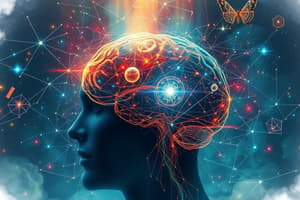Podcast
Questions and Answers
What is the primary function of sensation?
What is the primary function of sensation?
- To construct mental models of external stimuli
- To obtain input about the physical world through sensory receptors (correct)
- To interpret sensory information
- To organize input from the environment
How does perception differ from sensation?
How does perception differ from sensation?
- Perception is purely a physiological process.
- Perception is limited to the five traditional senses.
- Perception translates sensations into electrochemical signals.
- Perception involves organizing and interpreting sensations. (correct)
Which statement accurately describes transduction?
Which statement accurately describes transduction?
- Transduction involves the interpretation of sensory information.
- Transduction is a conscious experience of sensations.
- Transduction occurs only in the visual system.
- Transduction is the translation of sensations to the brain's electrochemical signals. (correct)
What is meant by constructive perception?
What is meant by constructive perception?
What does psychophysics study?
What does psychophysics study?
What is the primary function of the dorsal stream in visual processing?
What is the primary function of the dorsal stream in visual processing?
Which type of processing involves specific knowledge or experience affecting perception of a stimulus?
Which type of processing involves specific knowledge or experience affecting perception of a stimulus?
What is binocular disparity primarily associated with in terms of visual perception?
What is binocular disparity primarily associated with in terms of visual perception?
What happens to individuals with dorsal stream damage when tasked with matching lines?
What happens to individuals with dorsal stream damage when tasked with matching lines?
Which cue to depth perception involves the positioning of objects blocking others?
Which cue to depth perception involves the positioning of objects blocking others?
What is a main limitation of the template model in object recognition?
What is a main limitation of the template model in object recognition?
Which statement about image segmentation is true?
Which statement about image segmentation is true?
What change occurs to retinal images based on the distance of objects during motion, known as motion parallax?
What change occurs to retinal images based on the distance of objects during motion, known as motion parallax?
What does direct perception rely on when interpreting sensory information?
What does direct perception rely on when interpreting sensory information?
Which principle of Gestalt psychology involves grouping elements that are close together?
Which principle of Gestalt psychology involves grouping elements that are close together?
Which type of photoreceptor provides high spatial resolution and is capable of color vision?
Which type of photoreceptor provides high spatial resolution and is capable of color vision?
What does the term 'closure' refer to in Gestalt grouping principles?
What does the term 'closure' refer to in Gestalt grouping principles?
Which area of the visual brain is primarily involved in recognizing faces?
Which area of the visual brain is primarily involved in recognizing faces?
In constructive perception, what is primarily being made from sensory data?
In constructive perception, what is primarily being made from sensory data?
What is visual agnosia?
What is visual agnosia?
Which of the following best describes the figure-ground principle in perception?
Which of the following best describes the figure-ground principle in perception?
What is the primary role of the lateral geniculate nucleus (LGN) in the visual system?
What is the primary role of the lateral geniculate nucleus (LGN) in the visual system?
Which phenomenon occurs when the brain perceives ambiguous stimuli incorrectly?
Which phenomenon occurs when the brain perceives ambiguous stimuli incorrectly?
What is the primary function of the cochlea in hearing?
What is the primary function of the cochlea in hearing?
Which pathway is responsible for sound localization in the auditory system?
Which pathway is responsible for sound localization in the auditory system?
What type of receptors are primarily involved in the olfactory system?
What type of receptors are primarily involved in the olfactory system?
According to Weber's Law, what percentage of intensity change is typically required to notice a difference in two stimuli?
According to Weber's Law, what percentage of intensity change is typically required to notice a difference in two stimuli?
What contributes more to the flavor of food, according to the chemical senses?
What contributes more to the flavor of food, according to the chemical senses?
Which of the following is a characteristic of feature-based recognition?
Which of the following is a characteristic of feature-based recognition?
What role does context play in object recognition?
What role does context play in object recognition?
What mechanism allows the brain to compare sound input from both ears for localization?
What mechanism allows the brain to compare sound input from both ears for localization?
Which type of tactile receptors is involved in sensing touch?
Which type of tactile receptors is involved in sensing touch?
What is termed as the absolute threshold in stimulus detection?
What is termed as the absolute threshold in stimulus detection?
Flashcards are hidden until you start studying
Study Notes
Sensation vs. Perception
- Sensation: Input from the physical environment received by sensory receptors.
- Perception: Brain's process of selecting, organizing, and interpreting sensations, relying on senses.
- Transduction: Transformation of sensory input into electrochemical signals used by the brain.
Types of Senses
- Five traditional senses: Vision, Hearing, Touch, Smell, Taste.
- Additional internal senses: Proprioception, Nociception, Equilibrioception.
Perception as Inference
- Sensation example: Vibrations on ear hair follicles.
- Perception example: Interpretation of crying as a baby’s sound.
Psychophysics
- Studies the relationship between the physical qualities of stimuli and the psychological experience of them.
Theories of Perception
- Information is acquired through senses and processed by the brain, leading to:
- Constructive Perception: Mental model creation based on sensory information.
- Direct Perception: Behavior directly reacts to sensory input without a mental model.
Gestalt Psychology
- Concept: “The whole is greater than the sum of its parts.”
- Emphasizes organized wholes rather than isolated parts in perception.
Gestalt Grouping Principles
- Figure-ground: Differentiating foreground and background.
- Similarity: Grouping similar objects.
- Proximity: Grouping nearby elements.
- Continuity: Aligning elements perceived together.
- Closure: Completing incomplete forms or images.
- Common fate: Grouping moving objects together.
Visual System Overview
- Approximately 20% of the cortex is dedicated to visual processing.
- Eye structure: Light travels through Cornea, Iris, Pupil, and Retina.
- Images appear inverted on the retina.
Retina and Photoreceptors
- Rods: High sensitivity, low resolution, achromatic (black and white).
- Cones: Lower sensitivity, high resolution, responsible for color vision.
Visual Brain Functionality
- Lateral geniculate nucleus (LGN): Main relay center for visual information to the thalamus.
- Primary visual cortex (V1): Responds to basic visual patterns; higher areas respond to complex shapes.
Visual Perception Processing
- Bottom-up processing: No prior stimulus knowledge required.
- Top-down processing: Previous knowledge influences perception.
Depth Perception Cues
- Occlusion: Objects blocking others appear closer.
- Motion parallax: Distance perception based on the relative speed of object movement.
- Binocular disparity: Difference in retinal images between two eyes aids depth perception.
- Stereopsis: Perception of depth via disparity between the two eyes.
Object Recognition
- Involves matching stimuli to stored mental representations.
- Template model: Simplistic and inflexible recognition method.
- Classification: Identifying items as part of a category.
- Feature-based recognition: Recognizing common features across various object views.
Hearing and Sound Processing
- Sound pathway: Pinna → Ear canal → Eardrum → Ossicles → Cochlea.
- Cochlea: Contains hair cells and has a tonotopic organization for sound processing.
Auditory Cortex Functions
- Medial geniculate nucleus (MGN): Organizes and analyzes sound components.
- Primary Auditory Cortex (A1): Responds to pitch and rhythm.
Sound Localization Mechanisms
- Binaural cues: Use of both ears to determine sound location.
- Interaural time/level differences: Differences in sound arrival time and intensity between ears.
Chemical Senses: Smell and Taste
- Olfaction: Sense of smell, detects airborne chemicals.
- Gustation: Sense of taste, detects ingested chemicals.
- Olfactory pathway: Nostrils → Olfactory epithelium → Olfactory bulb.
Tactile Perception
- Mechanoreceptors send signals to the somatosensory cortex.
- Four types of tactile receptors exist, organized somatotopically.
Stimulus Detection Concepts
- Absolute threshold: Minimum intensity to detect a stimulus 50% of the time.
- Difference threshold (JND): Smallest detectable difference in stimulus magnitude.
- Weber’s Law: Difference detection relates to the proportion rather than the magnitude of stimuli.
Specific Conditions in Visual Processing
- Visual agnosia: Recognition difficulty for specific visual stimuli.
- Prosopagnosia: Impaired ability to recognize faces.
- Fusiform Face Area (FFA): Activates during facial recognition tasks.
This overview includes essential concepts regarding perception, sensation, and processing systems in both visual and auditory domains.
Studying That Suits You
Use AI to generate personalized quizzes and flashcards to suit your learning preferences.




